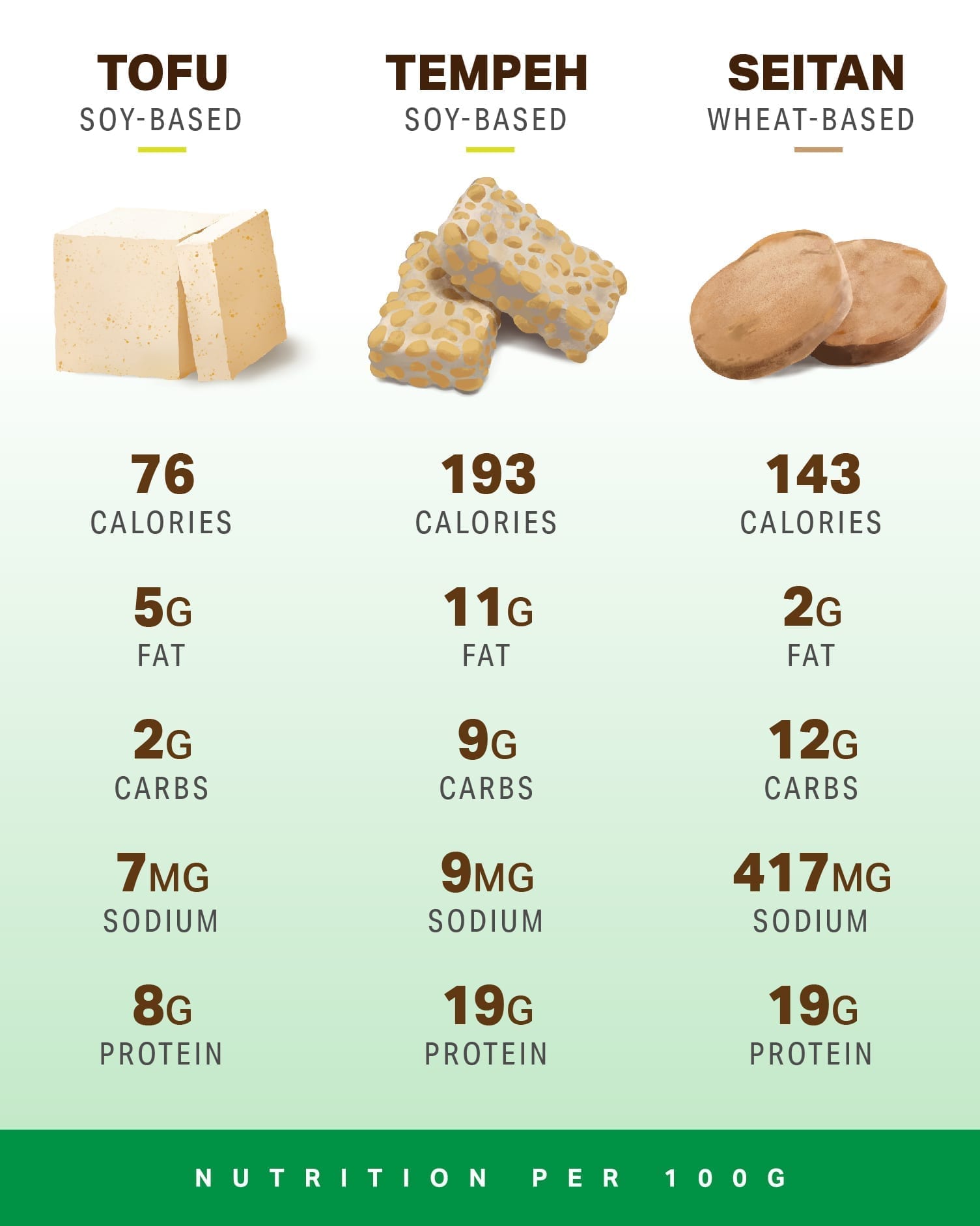Plant-based meat alternatives are having their moment in the sun, even for consumers who aren’t full-time vegetarians or vegans.
Did you know seven in 10 Americans eat plant-based foods and return for more? Of the households buying plant-based meals, 80% are repeat buyers.
Health is a primary reason people go plant-based, and science backs that choice. Eating more plant-based foods can help you reduce certain health risks, like heart disease and high blood pressure.
Fortunately, there are plenty of meat alternatives to explore. One popular comparison is tempeh vs. tofu vs. seitan — the plant-based trifecta.
Let’s dive in.
Plant-Based Proteins Explained
According to the Institute of Medicine, protein should make up 10% to 35% of your calories. This includes plant-based proteins.
What is tofu?
Tofu, or bean curd, is a popular meat substitute consisting of soybeans and water. The soy-water mix becomes tofu when you add a coagulant, which thickens and binds the mixture.
There are three types of tofu coagulants:
- Salts
- Acids
- Enzymes
Each has a different chemical effect on soy protein. Scientists are studying all three to learn which makes the best tofu.
TL;DR: Tofu consists of soybeans and water that are made into a paste with a binding agent.
What are the different types of tofu?
Tofu gets harder when you press more water out of it. The tofu industry has sorted tofu’s different hardnesses into three basic types:
- Silken tofu (also called “soft tofu”) has a creamy texture. It’s a popular ingredient in plant-based desserts and sauces.
- Medium tofu is the softest kind of tofu to come in a solid block.
- Firm tofu has the lowest water content and crumbliest texture. You find it in stir-fry dishes and even baked goods.
Most commercial tofu has one of these labels or a variation. “Medium-firm” or “extra-firm” are popular options.
In the end, though, tofu is a spectrum. The more water you press out, the firmer it gets.
What are the nutritional benefits of tofu?
Tofu is soy, which offers a long list of health benefits. For example:
- It may lower cholesterol. Many studies have shown that eating soy can reduce low-density lipoprotein (LDL) cholesterol, aka “bad cholesterol.”
- It supports heart health. Research shows eating more tofu can reduce your risk of coronary heart disease.
- It’s an excellent source of vitamins, minerals, and amino acids. Among other things, tofu is rich in iron, calcium, and vitamin A.
Different types of tofu have different nutrition profiles. For example, firmer tofu has a higher protein content than softer tofu. It’s denser, so it contains more soy per square inch.
You can find specific in the MyFitnessPal app. It might even inspire you to try a new type!
TL;DR: Tofu is good for your heart health and can help your body meet its nutrition needs and build muscle.
What is tempeh?
Tempeh is another soy-based plant protein. It traditionally comes from Indonesia, where it’s still the most popular soy product.
Making tempeh starts by soaking the soybeans, typically overnight, then boiling, draining, and fermenting them. The boiled soybeans are then mixed with a fungus called Rhizopus oligosporus. Some people call this “tempeh starter.”
The fermentation process takes a day or two. During that time, a white mold grows over the beans. It binds them into a large sheet, which you can cut and cook.
TL;DR: Tempeh is fermented, soaked soybeans made into a solid block.
Is tempeh tofu?
Tempeh and tofu are both soy-based and worth trying if you’re interested in a plant-based diet and can eat soy. But no, tofu and tempeh are not the same food.
Tempeh is fermented, so it has a different taste and texture. The fermentation process also changes the nutritional profile.
Let’s look at the nutritional difference between tempeh and tofu. Using the MyFitnessPal app, we can compare 3 oz. servings of tempeh and firm tofu.
The tempeh has:
- 16 g more carbs
- 0.5 g more fat
- 10 g more protein
So, in the tempeh vs. tofu protein face-off, tempeh is the clear winner. Tempeh also has more dietary fiber, potassium, and vitamin A.
But nutrients aren’t the only consideration. Tempeh has a stronger taste. It’s known for its bold and nutty flavor, while tofu is famously neutral and takes on a dish’s highlight flavors.
TL;DR: Tempeh or tofu? Tempeh wins for protein and contains more carbs than tofu. It also has a stronger taste.
What is the nutritional profile of tempeh?
A 3 oz. serving of tempeh contains:
- 18 g of protein
- 18 g of carbs
- 4.5 g of fat
Most of the fat in tempeh is unsaturated, with a ratio of about two grams of unsaturated to one gram of saturated. There are no trans fats.
What is a gluten-based alternative to tofu? The answer: seitan
If you have celiac disease — or any gluten intolerance — you’ll want to skip this section. But if your body is okay with wheat, it’s time to try seitan, a vegan protein made from wheat gluten.
You get seitan by extracting the gluten from wheat and mixing it with water. Add some spices, and voilà! Seitan.
Protein from gluten. Who knew?
Turns out, the ancient Chinese. Legend says Buddhist monks created seitan in the sixth century CE. Even then, it was a way to eat healthier without missing out on the benefits of meat.
Seitan’s texture is so much like chicken that some people call it “wheat meat.” It’s perfect if you want a food like tofu without tofu’s silky mouthfeel. It also makes a good substitute for tempeh if a nutty taste isn’t your favorite.
The main downside? Seitan doesn’t include lysine, an essential amino acid. Technically, that means seitan isn’t a complete protein. But don’t worry, it’s still healthy — you just need other sources of proteins, too.
TL;DR: Seitan is essentially wheat gluten, usually with spices added.
Is seitan processed?
Seitan is a processed food, meaning it’s altered from its natural state. To create seitan, you must extract the gluten from its natural state within the wheat.
That said, some seitan is more processed than others. Store-bought seitan includes more preservatives so it can reach you safely.
You can also buy flavored seitan. Those products might contain sauces with added sugar, oils, and other ingredients. Always check the ingredients list for what kind of seitan you’re buying and what’s been added.
If you want minimally processed seitan, your best bet is making it at home. The primary ingredient is vital wheat gluten, which you can buy in specialty stores.
TL;DR: Store-bought seitan is usually processed, but you can make it at home.
What are the seitan macros?
A 3.5 oz. serving of seitan contains:
- 6.6 g of carbs
- 5 g of fat
- 17 g of protein
The closest comparison, meat substitute-wise, is tempeh vs. seitan. Tempeh has slightly less protein, fewer carbs, and less fat.
Compared to tofu, seitan has significantly more protein. Tofu contains 7.6 g per 3.5 oz. serving. Seitan also has more carbs, making it a trade-off for some people.

Which Meat Alternative Is Right for You?
So, seitan vs. tofu vs. tempeh. Two are soy-based, and one is wheat-based. All are versatile and have similar macro profiles. Which to choose?
As with most things food-related, it depends on you. Your nutrition needs should determine your choice of meat substitute. Of course, your sense of taste can play a part, too.
Meat alternatives absorb the flavor of whatever you cook them with. They’re kind of famous for it. Prepare any of these proteins with your favorite herbs and spices, et voilà — customized protein.
Prepare tempeh, tofu, or seitan with your favorite herbs and spices. Instant customized protein! And download MyFitnessPal for more plant-based recipe inspiration.
Originally published November 19, 2019. Updated April 2, 2024





